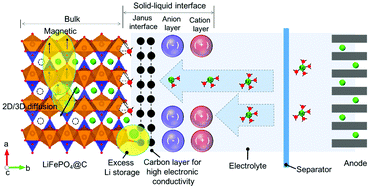Structure and performance of the LiFePO4 cathode material: from the bulk to the surface
Abstract
Currently, LiFePO4 is one of the most successfully commercialized cathode materials in the rechargeable lithium-ion battery (LIB) system, owing to its excellent safety performance and remarkable electrochemical properties and is expected to have a broader market in the near future. Although it is widely recognized that the crystalline structure of a cathode material largely dictates its electrochemical properties (e.g. capacity, cycle life and rate capabilities), this intrinsic connection in LiFePO4 has not been systematically reviewed. Different from the previous reviews, which mainly focus on the improvement of electrochemical performance by all kinds of techniques, in this review, the relationship between its electrochemical performance and bulk/surface structure is reviewed and discussed. First, it is revealed that the intra-particle Li+ transfer is influenced by several properties of the bulk, including crystalline structures, antisite defects and electronic structures. Next, it is demonstrated that the surface/interfacial structures of LiFePO4, which can be reconstructed artificially or spontaneously, also have great impacts on the performances. Lastly, the intrinsic connection between the structure and performance is preliminarily established, showing brand-new perspectives on the strategy for further improvement and contributing to a comprehensive understanding of LiFePO4.

- This article is part of the themed collections: Recent Review Articles and Celebrating 60 years of the Fujian Institute of Research on the Structure of Matter


 Please wait while we load your content...
Please wait while we load your content...